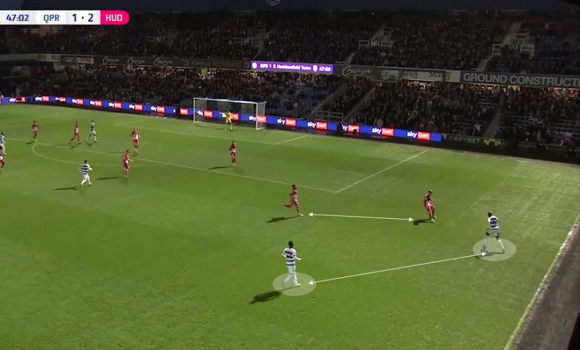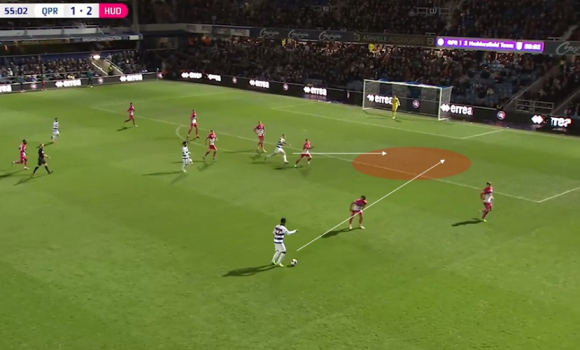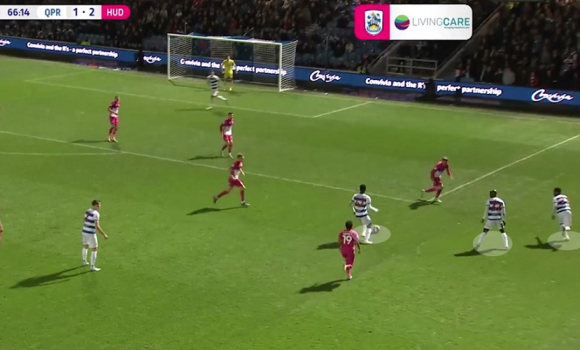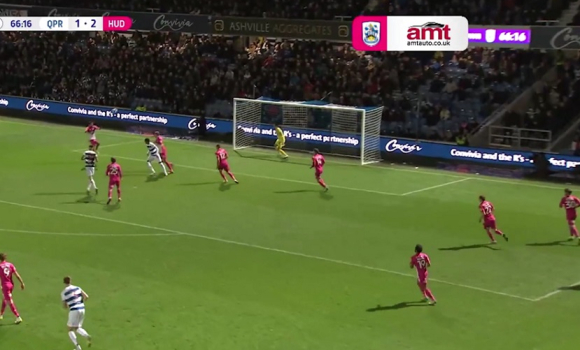Why are QPR struggling to break down defences? Analysis Thursday, 24th Nov 2022 12:38 by Dan Lambert A week that offered QPR a terrific chance to cement play-off credentials before the World Cup break ended in three torturous defeats and just a single goal scored — Dan Lambert’s latest analytics piece examines why Rangers have become so shot-shy. It proved a painful end to the first half of the Championship season — QPR finishing in QPR style with three defeats from three, including a pair of home losses to the bottom two sides in the league. There have been a few key themes/issues recently, defensive set plays one of them but I don’t think that’s a structural issue. The more pressing matter for me is breaking down defences, in particular mid to low blocks that suck the space away, compact central areas and force you to come up with solutions to counteract the shape. Short and sweet, we simply haven’t done that well enough. Using the last three games (West Brom, Huddersfield and Coventry) I’ve highlighted why we haven’t been successful at doing so, and offered a few solutions as a way of improvement. The most significant of the three games in highlighting this frustration was Huddersfield. Leading 2-1, with an hour to go, they were happy to sit in a low block with 11 men behind the ball. QPR’s 35 shots, a lot of wasted crosses and a lack of cutbacks probably sum up the issues with this game. Especially frustrating because the goal we did score, the one moment of quality we did produce, came when we didn’t cross but instead looked to create a cutback.
What I mean by the ‘cutback zone’ is the areas either side of the goal towards the by-line. These are chances created closer to the goal, therefore of a higher quality (as per the xG model) and just like shot locations, optimal crossing locations are important too because as much as deep crossing can work as a source for chances, you certainly gamble based on the quality of the delivery from further out as well as connecting with the delivery. This video with former Bristol City and current Hibs boss Lee Johnson explains the concept really well in a lot more detail… But it goes to show, in contrast to parts of QPR’s recent play I highlight later in the piece, how important it is to create better quality chances and have better off ball movement to break opposition structures out of possession. Lack of superiority with overloadsI spoke earlier about teams’ low blocks being centrally compact. When breaking them down you have three options: either to go through, around or over. With space limited behind the defensive line, going over seems tougher, and going through is also difficult, so going around was the more accessible route. Against Huddersfield, we played a double wide system (4-2-3-1- with a winger and FB) and as a minimum we had two attacking players down one side, but it left us at risk of having no superiority, which became a problem when they had enough men to match it and leave us in 1v1 situations.
Superiority, crossing and penetrating runsDespite not always having superiority in wide areas, in moments when we did, the decision making was not there to choose the appropriate next move to help create a better avenue to attack the shape across all three of these themes/scenarios.
These examples highlight that the off-ball movement and running has been there to create some good opportunities but decision making, in particular ignoring the underlapping runs in favour of crossing, seems very suboptimal. Also, it’s worth mentioning that the decline in Laird’s influence recently likely coincides with our attacking patterns. We saw earlier on in the season (Watford a good example) how dangerous his underlapping runs are, in particular his positioning to provide cutbacks. He’s not a full back that thrives with deep crossing.
A good 3v2 opportunity in the wide area is ignored to hit a cross into the box when we are numerically underloaded. A real theme with our decision making in the final third is coming to light here.
1v1 isolationsWhat was evident in the most recent game against Coventry was during the second half we were a bit more fluid and had quite a few 1v1 isolations in wide areas, particularly down the right-hand side. However, once again, we made poor decisions having worked those situations for ourselves.
The last image is telling, as the relationship between the front three seems a bit off at the moment. One makes the front post movement but the delivery is aimed for the deeper area. RotationsRotations are something we have thrived on when we’ve been at our best under Mick Beale. The interplay between the attackers in the final third to represent Beale’s fluid front three that he desires but we haven’t seen many rotations in wide areas lately. But when we have, the idea is there but the execution hasn’t been.
A promising rotation, something I’d have liked to see more of - the way space was manipulated through Chair’s movement to give Laird space to drive into was encouraging to see. Third man combinationsContinuing with the theme of poor decision making, it was also evident in the West Brom game where we get ourselves into some promising situations but made the wrong pass/decision that could have got us in behind or through their defensive shape using third man combinations. What I mean by third man combinations is a move/interplay which involves three players which I’ll look at in a couple of examples here...
A third man combination between Willock, Paal and Iroegbunam could occur to attack the space Iroegbunam is running into between the FB and CB.
Two really good examples where third man combinations to match the runs of Adomah and Iroegbunam could have broken the opposition’s structure and had the potential to create good chances in front of goal. In terms of the West Brom game and those third man combinations, I had a quick look in more detail with some video footage in this Twitter thread. Concluding thoughts- Crossing generally is an ineffective way of creating chances as we’ve seen from the quantity over quality For all Beale has waxed lyrical about his attack having freedom, fluidity and surprise for opposition attacks, the last month of games haven’t really offered that. My hope was we’d have time during the World Cup break to perfect that and rehearse some patterns too, but once again we’re consumed in speculation about whether the manager is even going to be here by the time we play again. Links >>> More like this at Dan’s SubStack >>> What have we learned so far? >>> QPR’s attacking set pieces If you enjoy LoftforWords, please consider supporting the site through a subscription to our Patreon or tip us via our PayPal account loftforwords@yahoo.co.uk. Pictures — QPRPlusPass The Twitter @DanLambert__ Ian Randall Photography Please report offensive, libellous or inappropriate posts by using the links provided.
You need to login in order to post your comments |
Queens Park Rangers Polls[ Vote here ] |
We in turn value your personal details in accordance with our Privacy Policy.






















